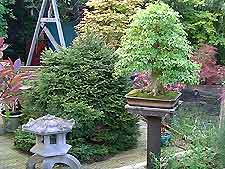Bonsai Trees
Wiring

There are many techniques for positioning branches, such as tying, hanging weights from them, using clamps and directional pruning (grow and clip), but by far the easiest and most effective way to do this precisely is by wiring them. It is one of the most important styling techniques and with patience, can quickly be mastered.
Copper wire and aluminium bonsai wire are the two choices available and both can produce excellent results. Aluminium wire tends to be easier to bend and apply, therefore thicker gauges are necessary for heavy branches. Anodised aluminium wire is very popular, being brown in colour and therefore inconspicuous when applied neatly. Copper wire, that has been soften by annealing, strengthens as it is bent and is more difficult to wind around branches, but does have the advantage that thinner gauges can be used. Never use copper wire on Prunus varieties as this species reacts badly to copper.
One of the most important aspects of wiring is to ensure that the wire is anchored securely before winding around the branch or trunk. If wiring two branches, use one length of wire for both so that they anchor each other. When wiring a trunk, carefully push the end of the wire into the soil to help hold it firmly. Take time to wire neatly and methodically at 45° to the branch or trunk. This is the optimum spacing for best effect. When wiring branches, make sure that the first bend is close to the trunk so that the branch is not torn or ripped away when being bent.
Wiring Tips
1. Perfect well spaced 45° wiring. This will be effective when bending the branch
2. For extra strength, rather than using thick wire, neatly add another piece of wire
3. Where two pieces of wire cross over, as the branch swells the sap flow will be stopped and the branch will suffer, eventually dying
Useful pointers to bear in mind when wiring:
- Always apply the wire neatly and carefully. It will not only be tidier and less obvious, but more effective. Wiring that has been well executed can be quite often be quite subtle and discreet
- Use the correct gauge of wire so that the branch or trunk stays in the exact position straight away and does not move. If unsure, test the flexibility of the tree first and compare it to the different wire available
- Never use wire that is too thick and difficult to apply. If the wire is not substantial enough to adequately bend, apply another wire of the same gauge parallel to the first wire, several times if necessary - this is much better than snapping or damaging branches as a result of struggling with unnecessarily thick wire
- Branches can be twisted around as well as bent up and down
- Depending on the thickness of the branch, wire may be left on for a period of between several weeks for very young shoots to over a year for more mature branches. As soon as the wire shows signs of biting into the bark, remove it so that it does not scar the bonsai. Small wire marks will soon disappear, but deep cuts can scar the tree forever. Replace if the branch moves from the desired position, keeping away from any previous wire marks
- When removing wire, to avoid damaging the bonsai it is safest to cut it off completely, rather than unwinding it
- At some stage during a tree's development, it is highly beneficial to wire every single branch and twig on the bonsai, so that they can be accurately placed where required. This can improve the bonsai considerably and immediately. If this seems a rather onerous task, divide the time into sessions over several days
- Support the area of branch or trunk being bent and bend slowly, gradually and carefully
- When planning to bend branches, allow the tree to dry out so that they become less turgid and not as full of sap. This helps make the branches more flexible, but take care not to let the bonsai become too dry as this can be damaging to the tree
- Thick branches that are to be bent drastically should be wrapped with several layers of raffia for extra support. By wetting the raffia first, it is easier to bind more tightly
- When bending a thick branch, hold it at the required angle as the wire is applied around the branch. This will help the branch to be repositioned more easily
 There are many techniques for positioning branches, such as tying, hanging weights from them, using clamps and directional pruning (grow and clip), but by far the easiest and most effective way to do this precisely is by wiring them. It is one of the most important styling techniques and with patience, can quickly be mastered.
There are many techniques for positioning branches, such as tying, hanging weights from them, using clamps and directional pruning (grow and clip), but by far the easiest and most effective way to do this precisely is by wiring them. It is one of the most important styling techniques and with patience, can quickly be mastered.